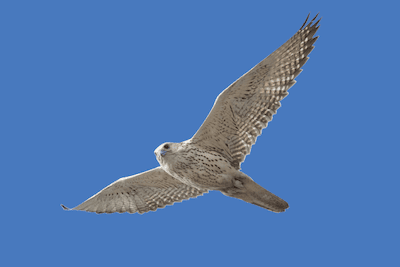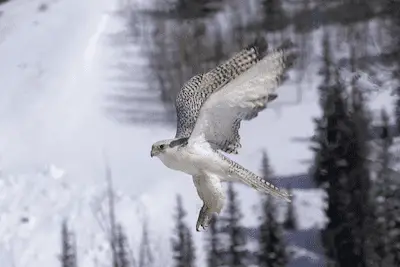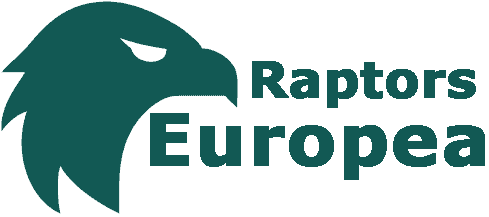Gyrfalcon
(Falco rusticolus)
The Gyrfalcon is the largest falcon species in the world, and lives in the northernmost reaches of Europe.

Gyrfalcons are specialized for life in the tundra, where they hunt medium sized birds such as Ptarmigans and Grouse.
The Gyrfalcon is a circumpolar species that occurs in a broad band across all countries that form part of the arctic tundra. In Europe it breeds in the northernmost parts of Scandinavia, Russia, and Iceland.
While the overall population of the Gyrfalcon is not threatened at this time, it is a rare raptor, and should be closely monitored to ensure a positive future for this beautiful falcon.
Gyrfalcon facts
As a very large falcon, it’s relatively easy to recognize a Gyrfalcon, if you have the good fortune to see one in the wild. You’re most likely to encounter it in open landscapes in Scandinavia, where it hunts birds close to the ground.
Gyrfalcon size
The Gyrfalcon is not only the largest falcon in Europe, but also the largest falcon species in the entire world. It has a wingspan comparable to that of the Common Buzzard.
- Wingspan: 111-128 cm
- Length: 50-60 cm
- Weight: 1,400-2,000 g (female), 950-1,300 g (male)
Gyrfalcon males are smaller than females, and can overlap in size with female Peregrine Falcons (Falco peregrinus).
Appearance
The Gyrfalcon is a big falcon that looks impressive not only because of its large size, but also because of its striking all-white plumage with dark grey and black spots, which resembles the color of a Snowy Owl.

Sexual dimorphism
Similar to many other raptors in Europe, male Gyrfalcons are significantly smaller than their female counterparts, to the extent that there is almost no size overlap between the two genders.
Lifespan
A maximum age of 19 years has been recorded for the Gyrfalcon in captivity, as well as 13 years in the wild.
Scientific name and taxonomy
The scientific name of the Gyrfalcon is Falco rusticolus. It forms a superspecies with the closely related Lanner Falcon (Falco biarmicus) and Saker Falcon (Falco cherrug).
Gyrfalcon distribution
The distribution of the Gyrfalcon in Europe includes the northernmost regions of Scandinavia, Russia, Iceland, and Greenland. Outside of Europe, its range extends circumpolar, and it is present in all countries in the arctic zone.
Gyrfalcon habitat
The preferred habitat of Gyrfalcons is the arctic tundra. Also occurs above the tree line in mountains, and hunts in open landscape with low vegetation. Often found close to seabird colonies, which contribute to its diet.
Gyrfalcon population size
The total European population of the Gyrfalcon is estimated to be between 1,300 and 2,300 breeding pairs. The largest number of Gyrfalcons is found in Greenland, with 500-1,000 pairs. Outside of Greenland, the largest number of pairs is found in Norway, with up to 500 pairs, and Iceland, with up to 400 pairs.
Gyrfalcon behavior
The Gyrfalcon is a very skilled hunter that takes birds in the air and on the ground. Hunts from a perch, by soaring, or by flying slowly at medium height until it spots prey on the ground below.
Feeding and diet
The main food source of Gyrfalcons are birds, of which Ptarmigan and Grouse form the largest part. Especially during the breeding season, Gyrfalcons specialize in hunting these species, and they can make up up to 90% of the Gyrfalcon’s diet. Outside of the breeding season, Gyrfalcons take a wide variety of different bird species, ranging from songbirds to seabirds.
Breeding
Similar to all falcon species in Europe, Gyrfalcons don’t build their own nest, but occupy old nests made by other raptors or ravens. In the tundra they often use nests built by Rough-legged Buzzards (Buteo lagopus). The female lays 2-4 eggs, which are incubated for up to 36 days. After the young falcons hatch, they stay in the nest for up to 55 days, and after fledging they continue to be fed by their parents for another 6 weeks.
Migration
The Gyrfalcon is a partial migrant, with high arctic populations migrating south in winter, while the lower arctic populations can be either sedentary or partially migratory. Juvenile birds disperse to areas with high density of prey species. In rare cases, Gyrfalcons fly all the way to central Europe or the British Isles during winter.
Gyrfalcon conservation status
The overall population of European Gyrfalcons appears to be stable, and the Gyrfalcon conservation status has thus been classified as “Least Concern” by BirdLife International. However, some populations, including the one in Greenland, have experienced declines in recent decades, and therefore should be monitored closely.
Threats
The biggest threats to the Gyrfalcon are illegal shooting and collection of eggs or young falcons. The latter is done in order to supply Gyrfalcons for falconry, since it is extremely popular among falconers, and having a Gyrfalcon comes with a lot of prestige in some countries of the Middle East.
